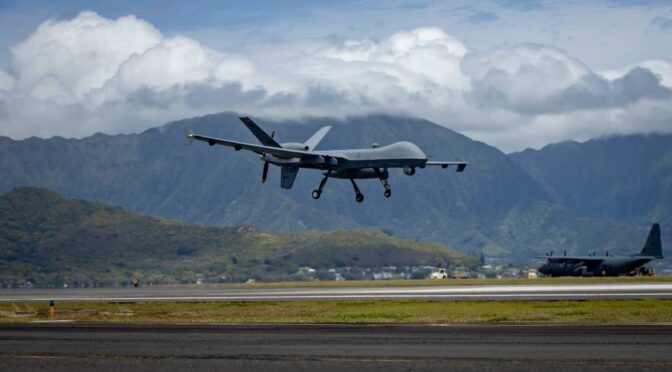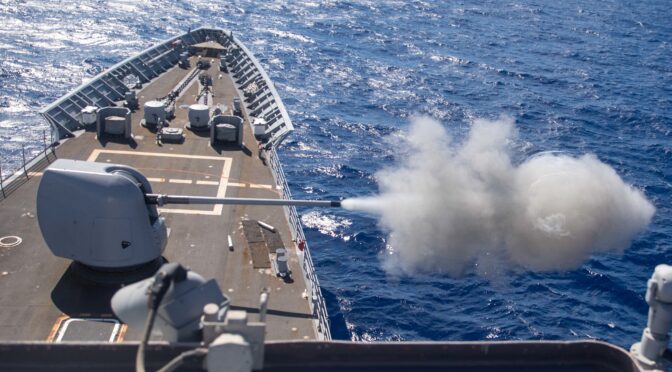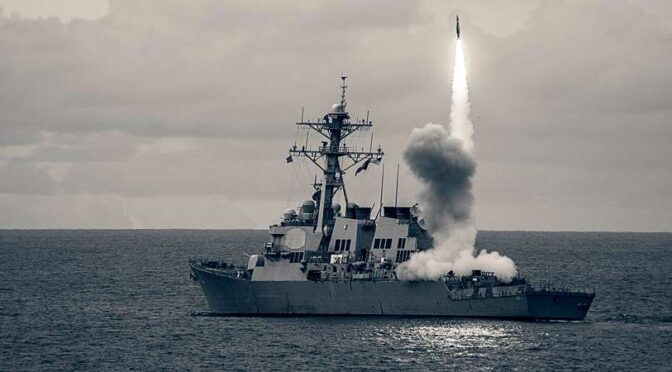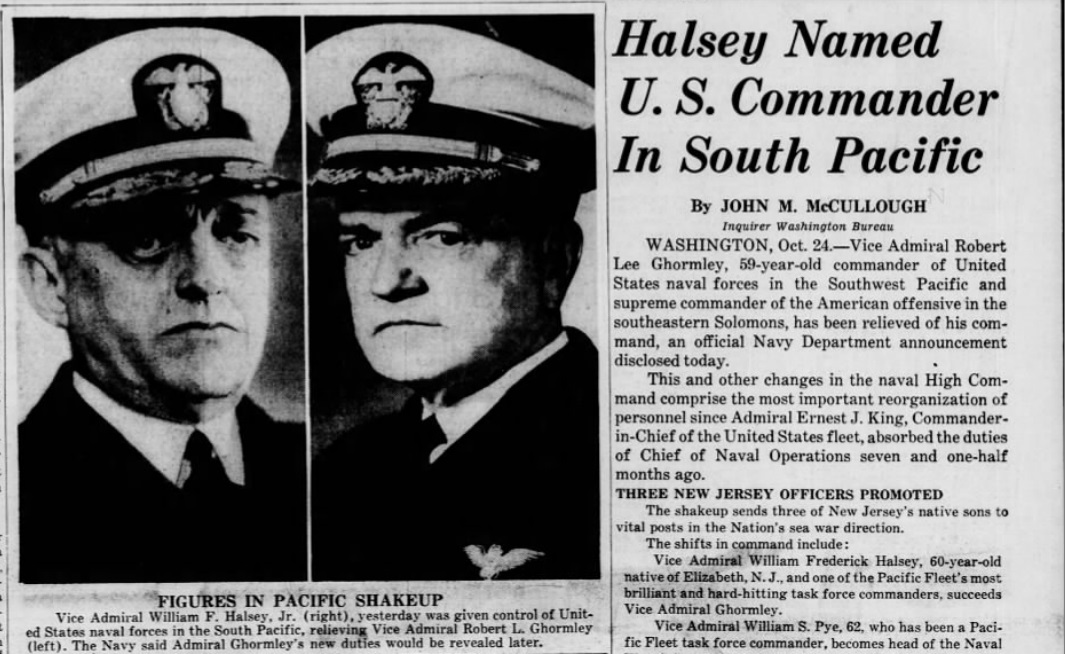By Commander A. P. Amila Prasanga, Sri Lanka Navy
Introduction
The rapid proliferation of military drones in the Indo-Pacific region has become a crucial feature of contemporary maritime security dynamics. Unmanned aerial systems (UAS), commonly known as drones, have revolutionized the way naval operations are conducted, presenting both challenges and opportunities for regional security. Understanding the strategic impact of this technological advancement is essential for shaping effective policies, strategies, and operational concepts in the Indo-Pacific region.
In recent years, there has been a significant increase in the deployment and utilization of military drones across the Indo-Pacific region. Various countries in the region have invested heavily in developing and acquiring these unmanned systems, aiming to bolster their defense capabilities and gain a competitive edge in the maritime domain. This proliferation has resulted in a diverse range of drone technologies and capabilities being deployed in the region, transforming the strategic landscape.
The strategic implications of military drone proliferation in the Indo-Pacific region cannot be underestimated. Drones have reshaped traditional naval operations, offering advanced surveillance, reconnaissance, and strike capabilities. Their ability to operate in contested areas, gather real-time intelligence, and project power with minimal risk to human lives has fundamentally altered the dynamics of maritime security. Understanding the strategic impact of drone proliferation is vital for assessing regional power balances, potential conflicts, and cooperative security efforts.
This comprehensive analysis aims to unveil the strategic impact of military drone proliferation on maritime security in the Indo-Pacific region. Through a combination of in-depth research and empirical analysis, this paper seeks to achieve several objectives. First, it assesses the current landscape of military drone proliferation in the Indo-Pacific, including the types of drones deployed and the countries involved. Second, it explores the strategic implications of drone proliferation on maritime security, investigating shifts in naval doctrines, force projection strategies, and asymmetric warfare dynamics. Furthermore, the study examines the challenges and opportunities for Indo-Pacific navies in integrating drones into their operational frameworks. Finally, it provides actionable recommendations for policymakers and military leaders to effectively respond to the strategic impact of drone proliferation. By shedding light on the complex interplay between drone technology and maritime security, this study aims to contribute to a better understanding of the evolving regional security dynamics in the Indo-Pacific.
Overview of Military Drones in the Indo-Pacific Region
The Indo-Pacific region has witnessed a significant diversification in the types and capabilities of military drones deployed by various countries. These UAS encompass a wide range of platforms, including reconnaissance drones, combat drones, and unmanned combat aerial vehicles (UCAVs). These drones possess varying capabilities such as long-range surveillance, real-time data gathering, target identification, precision strikes, and electronic warfare capabilities. Some advanced drones even feature autonomous capabilities and stealth technology, further enhancing their effectiveness in the maritime domain.
Several major countries in the Indo-Pacific region have been actively engaged in the proliferation of military drones. These include regional powers such as China, the United States, India, Japan, and Australia. Each country has its unique motivations for drone development and deployment. China, for instance, has focused on expanding its regional influence and protecting its maritime interests, while the United States has aimed to maintain its naval supremacy and support its allies. India, Japan, and Australia have sought to enhance their maritime capabilities and bolster their strategic postures in the region.
The deployment of military drones in maritime operations in the Indo-Pacific region has witnessed notable trends and patterns. Countries have increasingly utilized drones for surveillance and reconnaissance missions to gather intelligence, monitor maritime activities, and safeguard territorial waters. Additionally, drones have been employed for maritime domain awareness, border surveillance, anti-piracy operations, and maritime interdiction. The integration of drones into naval task forces and their coordination with other assets, such as surface vessels and submarines, has become more prevalent. Furthermore, there is an increasing emphasis on the development of swarming capabilities, enabling multiple drones to operate collaboratively and autonomously, which has the potential to significantly impact future maritime operations.
Understanding the types, capabilities, and motivations behind military drone proliferation in the Indo-Pacific region is essential to comprehend the evolving dynamics of maritime security. Analyzing current trends and patterns of drone deployment provides valuable insights into the changing strategies and capabilities of regional actors. This knowledge serves as a foundation for assessing the strategic implications and potential challenges posed by the increased utilization of military drones in the Indo-Pacific maritime domain.
Strategic Implications of Drone Proliferation on Maritime Security
The proliferation of military drones in the Indo-Pacific region has necessitated significant shifts in naval doctrines and operational concepts. Traditional naval strategies are being reevaluated and modified to incorporate the capabilities offered by drones. This includes the development of new concepts of operations (CONOPS) that maximize the advantages of drones in intelligence gathering, surveillance, and strike missions. Navies are increasingly integrating drones into their operational frameworks, redefining the roles and responsibilities of naval assets and personnel.
One of the most significant strategic implications of drone proliferation is the enhanced intelligence, surveillance, and reconnaissance (ISR) capabilities they provide. Drones equipped with advanced sensors and imaging systems can gather real-time data, monitor maritime activities, and detect potential threats with a high level of precision. This enables naval forces to maintain a comprehensive situational awareness, identify potential risks, and make informed decisions in a timely manner. The integration of drones into ISR operations has significantly expanded the coverage and effectiveness of maritime surveillance, enhancing overall maritime security.
The integration of drones in maritime security has also impacted traditional naval assets and force projection strategies. Naval forces are adapting to the changing strategic landscape by incorporating drones as force multipliers, allowing for more efficient and flexible operations. Drones can extend the reach of naval assets, provide a persistent presence in contested areas, and contribute to deterrence efforts. This shift in force projection strategies has led to a reevaluation of the size, composition, and capabilities of naval fleets.
The proliferation of military drones in the Indo-Pacific region presents both challenges and opportunities for naval force modernization. While drones offer numerous advantages, their integration into naval operations also brings forth challenges. These include technological limitations, training requirements for drone operators, cybersecurity concerns, and legal and ethical considerations. Additionally, the rapid advancement of drone technology necessitates continuous investment and adaptation to remain at the forefront of naval capabilities. However, successfully leveraging the opportunities presented by drone proliferation can enhance naval effectiveness, improve response capabilities, and contribute to regional maritime security.
Understanding the strategic implications of drone proliferation on maritime security is crucial for naval forces operating in the Indo-Pacific region. By adapting naval doctrines, capitalizing on enhanced ISR capabilities, reevaluating force projection strategies, and effectively addressing challenges and opportunities, navies can effectively navigate the evolving security landscape and contribute to the maintenance of regional stability.
Geopolitical Dynamics and Regional Security
The proliferation of military drones in the Indo-Pacific region has intensified competition among countries, while also fostering opportunities for cooperation. As countries invest in drone technology, there is a rivalry to develop and deploy advanced drones to gain a competitive edge. This competition has led to an increase in defense spending, technological advancements, and the pursuit of innovative operational concepts. However, the shared challenges and potential benefits of drone technology also create opportunities for cooperation. Countries may collaborate on research and development, information sharing, joint exercises, and the establishment of common standards and protocols for drone operations.
The widespread adoption of military drones in the Indo-Pacific region also has the potential to impact power dynamics and regional balance. Countries that effectively integrate and leverage drone capabilities may enhance their military effectiveness, influencing the balance of power in the region. Drones can provide a force multiplier effect, enabling smaller countries to project power and assert their interests. This could potentially lead to shifts in regional alliances, strategic alignments, and the redistribution of influence. The strategic implications of drone proliferation extend beyond the capabilities of individual countries and have implications for the broader regional security architecture.
The emergence of military drones as a critical component of maritime security in the Indo-Pacific region has significant implications for strategic partnerships and alliances. Countries that possess advanced drone capabilities may strengthen existing partnerships and alliances by providing support, sharing knowledge, and conducting joint operations. Additionally, the integration of drones into existing cooperative frameworks, such as information sharing networks, maritime security initiatives, and multilateral exercises, can enhance the effectiveness of regional security cooperation. However, differing technological capabilities and strategic interests related to drone proliferation may also create challenges in forging and sustaining partnerships and alliances.
Understanding the geopolitical dynamics and regional security implications of military drone proliferation is essential for policymakers and military leaders in the Indo-Pacific region. The competition and cooperation surrounding drone technology, its impact on power dynamics and regional balance, and the implications for strategic partnerships and alliances shape the regional security environment. By analyzing these dynamics, countries can navigate the changing landscape, assess potential risks and opportunities, and make informed decisions to maintain stability, foster cooperation, and address shared security challenges in the Indo-Pacific.
Ethical and Legal Considerations
The proliferation of military drones in the Indo-Pacific region raises ethical and legal concerns regarding targeted killings and the use of force in maritime operations. Drones equipped with precision strike capabilities have been utilized for targeted killings, raising questions about the legality and morality of such actions. The use of lethal force through drones in maritime operations requires a careful examination of legal frameworks, including international humanitarian law, human rights law, and the law of armed conflict. It is essential to establish clear guidelines and criteria for the use of force, ensuring transparency, accountability, and compliance with legal standards.
The increased deployment of military drones for surveillance activities in the maritime domain raises privacy and human rights concerns. Drones equipped with high-resolution cameras and sensors can collect vast amounts of data, including images and information about individuals and communities. The indiscriminate or unauthorized use of drones for surveillance can infringe upon privacy rights and violate human rights. It is imperative to establish robust safeguards, oversight mechanisms, and regulations to protect privacy rights, ensure data security, and mitigate potential abuses.
The use of military drones in the Indo-Pacific region necessitates adhering to international norms, promoting transparency, upholding human rights, and engaging in dialogue and cooperation. In doing so, countries can mitigate risks, build trust, and foster a conducive environment for the sustainable and ethical use of drones in maritime security operations. Compliance with these norms and frameworks is crucial to prevent misunderstandings, minimize the risk of conflict escalation, and maintain regional stability. Countries should actively engage in discussions and cooperation to develop common standards, share best practices, and enhance understanding of the legal implications of drone use in maritime security.
Technological Challenges and Opportunities
The integration of drones into naval operations and command structures presents both challenges and opportunities. Effectively incorporating drones requires the development of compatible communication systems, data integration protocols, and command and control mechanisms. This integration enables seamless coordination between manned and unmanned platforms, ensuring optimal utilization of resources and enhancing operational effectiveness. Navies must invest in developing interoperability standards, establishing efficient workflows, and adapting their organizational structures to fully leverage the capabilities of drones in maritime security.
The widespread adoption of military drones necessitates the training and skill development of drone operators and support personnel. Operating drones in a maritime environment requires specialized knowledge and expertise. Drone operators must possess a comprehensive understanding of the equipment, software, and mission-specific requirements. Furthermore, support personnel, including maintenance technicians and data analysts, must be adequately trained to ensure the reliability and effective utilization of drone systems. Investing in training programs, simulation exercises, and continuous professional development is essential to build a skilled workforce capable of maximizing the potential of drones in naval operations.
The proliferation of military drones in the Indo-Pacific region has significant impacts on defense industrial capabilities and technology transfer. As countries develop and deploy drone systems, there is a need for domestic production capabilities, including research and development, manufacturing, and maintenance facilities. The acquisition and integration of drone technology may also involve technology transfer agreements between countries. These agreements have implications for national security, intellectual property rights, and industrial collaboration. Careful consideration of these factors is crucial to ensure sustainable defense industrial capabilities and to facilitate responsible technology transfer in the context of drone proliferation.
Navigating the technological challenges and opportunities associated with military drone proliferation requires proactive measures and strategic planning. By focusing on the integration of drones into naval operations and command structures, investing in training and skill development for personnel, and carefully managing defense industrial capabilities and technology transfer, countries can capitalize on the potential of drones to enhance maritime security. This will enable navies to effectively address emerging threats, improve operational efficiency, and maintain a competitive edge in the Indo-Pacific region.
Future Trajectories and Recommendations
The future trajectories of drone technology and deployment in the Indo-Pacific region hold significant implications for maritime security. Anticipated developments include advancements in drone capabilities, such as longer endurance, increased payload capacity, and improved autonomy. Additionally, the integration of artificial intelligence (AI) and machine learning algorithms is expected to enhance drone performance and decision-making capabilities. Understanding these anticipated developments is crucial for navies and policymakers to stay ahead of the curve and effectively adapt their strategies and operational concepts.
To address the strategic impact of military drone proliferation on maritime security in the Indo-Pacific region, several policy recommendations can be put forth. First, navies and policymakers should prioritize the development of comprehensive regulatory frameworks and guidelines that ensure responsible and accountable use of military drones. This includes guidelines for the use of force, data protection, privacy, and compliance with international legal norms. Second, investments should be made in research and development, innovation, and acquisition programs to keep pace with evolving drone technologies. Navies should consider the procurement of advanced drones and the development of indigenous drone capabilities. Third, fostering regional cooperation and dialogue among Indo-Pacific navies is essential. Establishing information sharing mechanisms, conducting joint exercises, and promoting collaboration on drone-related research and development can enhance regional security and interoperability.
In the context of evolving drone technology and its impact on maritime security, collaborative efforts and information sharing are crucial for enhancing regional security in the Indo-Pacific. Navies should establish platforms for sharing best practices, lessons learned, and intelligence related to drone operations. This can facilitate a common understanding of emerging threats, enable the development of effective countermeasures, and enhance regional situational awareness. Additionally, regional security frameworks, such as ARF (ASEAN Regional Forum), ASEAN Defense Ministers’ Meeting-Plus (ADMM-Plus) and the Quadrilateral Security Dialogue (Quad), Five Power Defense Arrangements (FPDA) can serve as platforms for dialogue and collaboration on drone-related security issues.
Finally, understanding future trajectories and providing recommendations is vital for Indo-Pacific navies and policymakers to navigate the strategic impact of military drone proliferation on maritime security. Anticipating developments in drone technology and deployment, formulating policy recommendations, and fostering collaborative efforts and information sharing will contribute to a more secure and stable Indo-Pacific region. By proactively addressing these aspects, navies can harness the potential of military drones while mitigating associated risks and challenges, thereby shaping the future of regional security dynamics.
Conclusion
The strategic impact of military drone proliferation on maritime security in the Indo-Pacific region necessitates proactive approaches. Navies and policymakers must recognize the transformative nature of drones and their implications for regional security. It is crucial to stay ahead of technological advancements, adapt operational concepts, and develop comprehensive regulatory frameworks. Proactive measures include investments in research and development, capacity-building programs, and collaborative efforts among navies. By taking a proactive approach, navies can effectively address emerging challenges and leverage the opportunities presented by drone proliferation.
While this analysis has shed light on the strategic impact of military drone proliferation on maritime security in the Indo-Pacific region, further research is needed. The evolving nature of drone technology and its implications require continued monitoring and analysis. Future research should delve into specific aspects such as counter-drone measures, the impact on non-state actors, and the role of drones in asymmetric warfare. Additionally, interdisciplinary studies involving experts from the fields of law, ethics, technology, and international relations would contribute to a more comprehensive understanding of the subject matter.
In conclusion, proactive approaches, informed by research and analysis, are vital in addressing the strategic impact of military drone proliferation on maritime security in the Indo-Pacific region. By embracing the opportunities, managing the challenges, and adhering to ethical and legal principles, navies and policymakers can effectively harness the potential of drones while maintaining regional stability and security. Continuous monitoring and further research will ensure that strategies and policies remain adaptive and responsive to the evolving dynamics of drone proliferation in the Indo-Pacific region.
Commander Amila Prasanga is a Military Research Officer at the Institute of National Security Studies, the premier think tank on National Security established and functioning under the Ministry of Defence Sri Lanka. The opinions expressed are his own and do not necessarily reflect the positions of the institute or the Ministry of Defence, Sri Lanka.
Featured Image: An Air Force MQ-9 Reaper, assigned to the 49th Wing, lands at Marine Corps Air Station Kaneohe Bay, Hawaii, July 6 during Rim of the Pacific 2022. (Credit: Lance Cpl. Haley Fourmet Gustavsen/Marine Corps)





